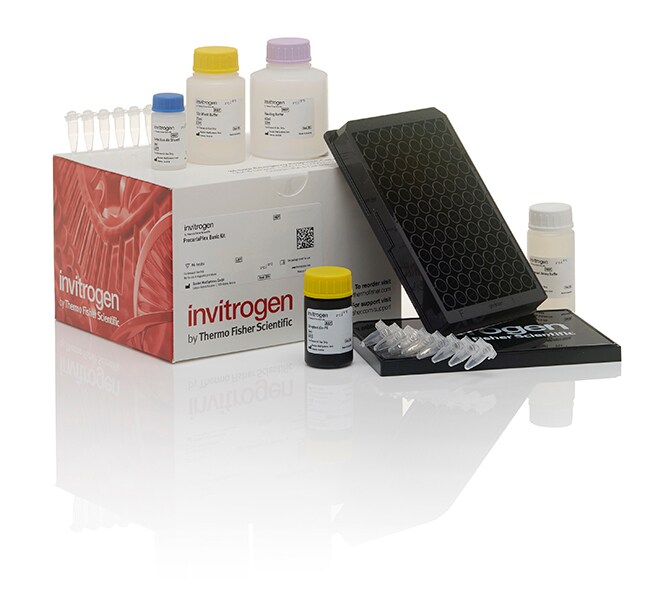
The ProcartaPlex Human Endothelial Injury Marker Panel 12plex enables research in the area of vascular endothelial cell injury and regeneration by looking at 12 protein targets in a single well using Luminex xMAP technology. Simultaneous detection of these targets can help researchers explore diseases that are characterized by vascular injury, such as cardiovascular disease, atherosclerosis, peripheral vascular disease, and inflammatory processes involving endothelial cells. In addition, endothelial dysfunction is described as an extrapulmonary manifestation of SARS-CoV-2 virus infection, so researchers are also focusing on COVID-19 and post-COVID-19 syndrome or long COVID in the context of a vascular disease.
The panel is provided in a ready-to-use format with individual vials of capture and detection reagents including 1X bead mix and detection antibody mix requiring less pipetting and experimental setup. Therefore, it is not combinable with Simplex kits or other ProcartaPlex panels.The following panels are complementary to this panel, with additional protein targets relevant in this research area: Human Angiogenesis Panel 18plex (Cat. No. EPX180-15806-901), and Human Atherosclerosis Panel 1 9plex (Cat. No. EPX090-15822-901).
In addition, targets relevant in vascular injury research requiring sample pre-dilution (1:100) are combined in Human Angiogenesis Panel 2 3plex (Cat. No. EPX030-15807-901) and Human Atherosclerosis Panel 2 4plex (Cat. No. EPX040-15824-901). Targets included in Simplex kits or combined in a custom panel are endoglin, sICAM-1, sVCAM-1, VE-cadherin.
ProcartaPlex pre-configured panels are extensively tested for analyte combinability, interference, and cross-reactivity to provide the highest level of validation and precision. All ProcartaPlex panels are supplied with the necessary reagents to perform the assay.
Target List [bead region]: E-selectin [77], P-selectin [55], VEGF-A [78], VEGF-D [53], PECAM-1 [72], Angiopoietin-1 [13], Syndecan-1 [14], VEGF-R2 [18], VEGF-R3 [57], MMP-1 [64], Thrombomodulin (TM) [73], VLA-4 [42]
ProcartaPlex immunoassays are based on the principles of a sandwich ELISA, using two highly specific antibodies binding to different epitopes of one protein to quantitate all protein targets simultaneously using a Luminex instrument. ProcartaPlex multiplex assays require as little as 25 μL of plasma or serum, or 50 μL of cell culture supernatant, and just four hours to obtain analyzed results.
• Reproducible, reliable results—validated as a panel to the highest industry standard, including protein target combinability and cross-reactivity testing
• More results per sample—measure multiple protein targets simultaneously in a single 25–50 μL sample
• Well-established Luminex technology—the most referenced multiplexing platform for protein detection and quantitation
ProcartaPlex assays utilize Luminex xMAP (multianalyte profiling) technology for the simultaneous detection and quantitation of up to 80 protein targets in a single 25–50 μL sample—from plasma, serum, cell culture supernatants, and other bodily fluids.
The Luminex MagPlex superparamagnetic microsphere beads in the ProcartaPlex assay are internally dyed with precise proportions of red and infrared fluorophores to create 100 spectrally unique signatures that can be identified by the Luminex xMAP detection systems (Luminex 200, FLEXMAP 3D, and MAGPIX systems). Similar to a sandwich ELISA, the ProcartaPlex assay uses matched antibody pairs to identify the protein of interest. In a multiplexed assay, each spectrally unique bead is labeled with antibodies specific for a single target protein, and bound proteins are identified with biotinylated antibodies and streptavidin–R-phycoerythrin (RPE). The conjugation of protein-specific antibodies to a distinct bead allows for analysis of multiple targets in a single well.
The most significant difference between a ProcartaPlex assay and ELISA is that the capture antibody in the ProcartaPlex assay is conjugated to a magnetic bead and not adsorbed to the microplate well, so the ProcartaPlex assay reagents are free-floating in the solution. For detection, the Luminex 200 instrument, for example, contains two lasers, one to distinguish the spectral signature of each bead and the second to quantify the amount of RPE fluorescence, which is proportional to the amount of protein present in the sample. ProcartaPlex multiplex assays can profile more target proteins using significantly less sample in the same time that it takes to perform a traditional sandwich ELISA.
ProcartaPlex multiplex panels are available in multiple formats across six species (human, mouse, rat, nonhuman primate, porcine, and canine). Visit thermofisher.com/procartaplex for more information and available products.
| Code | Description |
|---|---|
| EPX120-15849-901 | Catalog Number: EPX120-15849-901 |

